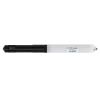Turner Designs C-FLUOR Submersible Sensors
Features
- Analog 0-5 VDC or digital RS-232 output options
- Factory calibrated and includes a calibration certificate
- Titanium construction with 2000m depth rating
- Free ground shipping
- Expedited repair and warranty service
- Lifetime technical support
- More
Overview
Turner Designs C-FLUOR Submersible Sensors are sensitive, extremely low power single wavelength in situ fluorescence and turbidity probes available in several optical configurations spanning a broad range of applications. Factory-calibrated, each C-FLUOR ships with a calibration certificate used to convert the output signal to a specific concentration estimate. The Titanium construction allows for a depth rating of 2,000 meters as well as superior resistance to corrosion.
Compatibility
Analog C-FLUOR Probes are pin-compatible with Cyclops Sensors, so they are easily integrated into many of the same third-party systems that accept 0-5V signals. Digital C-FLUOR Probes can be integrated with data loggers that accept ASCII data strings.
- Turner Designs C-FLUOR Submersible Sensor Specifications
- Turner Designs C-FLUOR Analog Submersible Sensor Manual
- Turner Designs C-FLUOR Digital Submersible Sensor Manual
- Turner Designs C-FLUOR Analog Submersible Sensor Quick Start Guide
- Turner Designs C-FLUOR Digital Submersible Sensor Quick Start Guide
- Turner Designs C-FLUOR and Cyclops-7F Comparison Guide
In The News
From Pans to Buoys: Advancing Reservoir Evaporation Rate Monitoring in Texas
In warmer climates like Texas, high reservoir evaporation rates can lead to declines in water level and water availability during droughts, making monitoring essential in order to ensure water security during times of scarcity. According to the Texas Water Development Board (TWDB), evaporation rates in Texas were previously based on data collected from a sparse network of Class A evaporation stations, dating back to the 1960s. These pans were stationed near reservoirs and still remain a widely accepted standardized approach to measuring evaporation rates on land. Monthly pan-to-lake coefficients were developed in the 1980s to connect the data collected from the pans to known lake conditions, extrapolating evaporation rates of the lakes using the pan data.
Read MoreA Drop in the Ocean: Restoring London’s Tidal Thames
The United Kingdom has grappled with wastewater management problems for decades. Although sewage treatment in the 20th century allowed many rivers, including the tidal Thames, to have healthy fish populations, combined sewer overflows into rivers–most commonly during heavy rainfall–affected water quality and occasionally even killed fish. Problems reached a head in 2012 when multiple infractions of European urban wastewater treatment laws threatened costly fines, on top of the environmental cost of repeated sewage spills into British rivers. Fast forward to 2025, and after a decade of construction work, London’s Thames Tideway Tunnel , affectionately dubbed the “super sewer”, is now fully activated and ready for testing.
Read MoreHave You Heard? AI Buoys Revolutionizing Marine Mammal Monitoring in Whangārei Harbor, New Zealand
In one history, Whangārei Harbor, nestled in the lush hills of New Zealand’s North Island, gets its name from the Māori, “waiting for the breastbone of the whale.” It seems fitting, then, that it’s now home to state-of-the-art acoustic monitoring buoys listening for marine mammals around the clock. In September 2024, a team from Auckland-based underwater acoustics firm Cetaware Ltd installed NexSens buoys in Northport, a major commercial port at the entrance to the Whangārei Harbor. The first buoys to be installed by Cetaware in a permanent setting running 24/7, they use real-time artificial intelligence (AI) models to passively sense Delphinidae–from common dolphins to orcas. Dr.
Read More













































